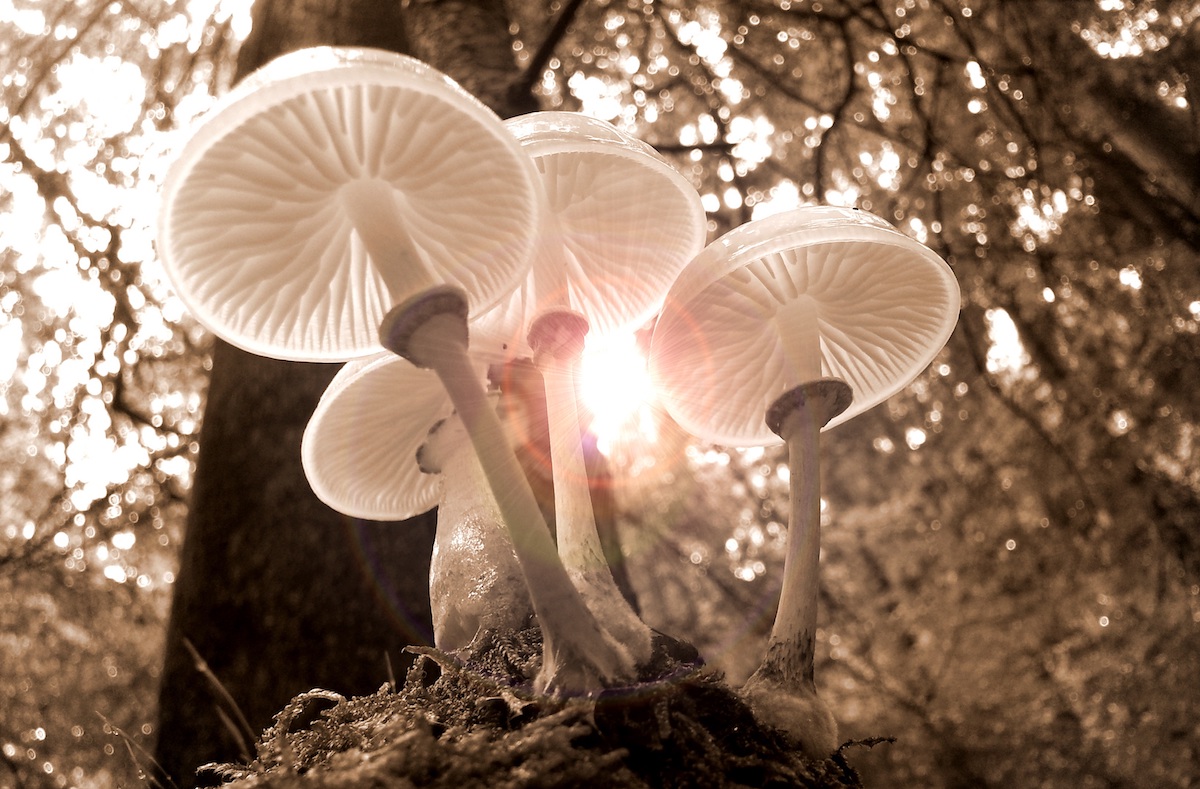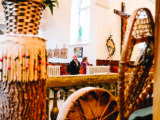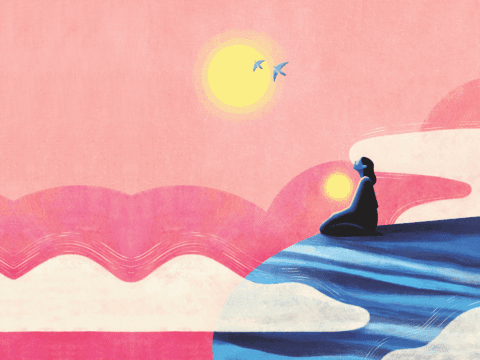Editor’s note: The experiences reported in the post below were undertaken solely on the initiative of the author, a freelance writer, as part of her “Year of Living Spiritually” — a personal project that involves experimenting with sacred activities outside of a religious setting. The Observer does not encourage or condone the use of drugs by its contributors. The possession and sale of psilocybin-containing mushrooms is illegal under the Criminal Code of Canada.
My friend Miranda* carefully lays out seven mushrooms next to a pretty china mug, which is decorated with tiny blue roses and the words, “Good Luck.” The dried stems are several inches long and their sturdy, perfectly round caps serve as protection for the dark underbelly of delicately divided gills. They make for an exquisite, botanical tableau on her stainless steel kitchen island.
You may unsubscribe from any of our newsletters at any time.
But these aren’t your run-of-the-mill portobello or cremini varieties. Rather, they are Psilocybe cubensis — or magic mushrooms — the most popular species of psychedelic mushrooms. They contain psilocybin, a chemical that interacts with serotonin receptors in the brain, causing hallucinations, a flood of euphoria (and, occasionally, paranoia) and the kind of profound insights that reputedly make people trade in their Audis and business suits for a rickshaw and orange robe to go live on an ashram — or at least want to.
These humble fungi have been used for thousands of years to create visions, produce revelations and communicate with the gods. They were consumed by the Saharan aboriginal tribes of Africa in 7000 B.C., by native North American Mayan and Aztec cultures and by the “turn on, tune in, drop out,” anti-establishment hippies of the 1960s. And now, by me, an average, middle-aged Canadian mother who has only tried pot twice (decades ago) and who regularly lectures her two daughters on the dangers of illicit drug use.
Miranda chops the mushrooms into small pieces, and adds boiling water and a heaping teaspoon of honey. It’s an attempt to sweeten a mixture that tastes like wet sawdust. I carry the cup upstairs to her cosy bedroom, which overlooks a massive maple tree whose leaves will soon be throbbing with vivid purple halos. Miranda, a registered nurse who knows what to do if I’m overcome by panic or psychosis, is a believer in the healing properties of psilocybin. It helped fast track her recovery from a recent divorce. As for me, I’m ready for anything and everything.
People who take psychedelics like psilocybin (30 million Americans, according to the U.S. National Library of Medicine) also report experiencing the transcendence of the ego; heightened creative powers; the alleviation of mental health issues and addiction; renewed appreciation for family and friends; the ability to realize objective truths about their own reality; and, yes, a sense of being one with the universe.
Back in 1962, Harvard University conducted its Good Friday Experiment on 20 theological students to determine whether psilocybin could induce spiritual experiences among believers. The majority of participants reported profoundly positive effects and, 25 years later, continued to characterize the event as one of the high points of their spiritual lives (Some participants eventually became ministers). In the spirit of the Good Friday Experiment, researchers at Johns Hopkins University more recently enlisted two dozen religious leaders (priests, ministers, rabbis and a Buddhist among them) to assess how a psilocybin-induced transcendental experience will affect their religious thinking. The study has yet to be completed, but researchers have noted that ideas about religion seem to shift from the parochial to the universal after a psychedelic experience.
Once inside Miranda’s bedroom, I stretch out on her queen-sized bed. I cue up my psilocybin playlist that my 20-year-old daughter Ruby helped me to download earlier (only after I explained why I was doing “magic mushrooms” and assured her of my precautions). And I prepare for a journey that will whisk me through the portals of my subconscious. There’s a bell within arm’s length on the nightstand if I need to summon her from downstairs. Within 10 minutes, my toes are tingling. A few minutes later, the large potted fern at the foot of the bed starts to sway wildly. Outside the window, some of the leaves on the maple tree are purple and pulsating. And though I don’t see the face of God, I catch sight of what appears to be an angel in a corner of the room. Even knowing that Miranda is keeping watch downstairs, I freak out a little, worrying that the visions will get stronger and become overwhelming. I also experience bouts of hysterical laughter so intense that they make my stomach hurt, along with undulating waves of energy from the tips of my toes to the crown of my head.
At one point, I pick up my notepad to steady myself. In that moment, I decide to journal throughout this entire experience, making a note of my thoughts and the corresponding time on the digital clock at my bedside. I write for four of the five hours of my ‘trip’ — at some points it’s so difficult to get the words down that I simply print block letters on the page as if I am a kindergartner. I fill 82 pages in all:
10:00 a.m.: “I am trying to write on the lines. It is hard.”
10:12 a.m.: “Is this joy for real?”
10:20 a.m.: “I feel warm all over.”
10:22 a.m.: “I love everyone.”
10:30 a.m.: “I have to pee, but I don’t want to get up.”
10:37 a.m.: “Alcohol is stupid compared to this.”
10:44 a.m.: “This is the best feeling I have ever known.”
11:01 a.m.: “Writing is a useless way to document this experience.
11:16 a.m.: “I give in.”
11:32 a.m.: “Everyone should do this.”
11: 40 a.m.: “Everything is beautiful.”
11: 44 a.m.: “We need to love as we want to be loved.”
12:01 p.m. “I don’t want to waste my life on dumb stuff like Netflix
12:09 p.m.: “I’m not even going to have a hangover?”
12:27 p.m.: “What’s that I smell? Something baking?”
12:36 p.m.: “I have to pee.”
12:40 p.m.: “Suffering is so unnecessary.”
12:58 p.m.: “How am I going to write about this?”
1:05 p.m.: “What if my pen runs out of ink.”
1:06 p.m.: “Is that a cake I smell?”
1:12 p.m.: “I should play the ukulele more.”
1:25 p.m.: “We should sell the house. It’s too big. We can be happy anywhere.”
1:58 p.m.: “Any unhappiness I feel is self-inflicted.”
2:12 p.m.: “I feel healed.”
2:30 p.m.: “I don’t want this ‘trip’ to end.”
2:35 p.m.: “Anything can be bearable if you can feel like this — even death.”
2:42 p.m.: “I am awakened.”
2:47 p.m.: “It’s like I’ve figured out all my problems. What the heck?”
3:02 p.m.: “I really need to pee.”
When I first begin journaling, my writing takes the form of a letter to my 17-year-old daughter Lucy, who is likely headed for art school next year. She loves to draw elaborate calligraphic compositions in which the words are perfectly spaced and the letters are elegantly embellished. As I write, my words take on the exact same shape of her beautifully scripted letters. But I’m no artist. (What I’m seeing, in fact, is part of a hallucinatory effect known as synesthesia — or seeing colours in letters and numbers). One second, the writing is in my usually slanted messy style. In the next, it’s as perfectly formed as Lucy’s artwork, replete with glowing colours and fancy swirls. They’re the result of a mind-altering illusion but seem completely real. And it’s at this moment that I realize that my daughter has done mushrooms herself — that she’s replicated psychedelic writing in her own artwork.
Initially, I’m alarmed and start to lecture her in my letter. But then, I’m acknowledging how wondrous this psilocybin experience is. I tell her that I’m proud that she’s an artist and that we should all be creating more beautiful things. I imagine myself as she must sometimes see me: an often uptight mother who cares more about the shoes piled up in the front hallway than making art, insists on eating dinner at a certain time and who craves order instead of giving into the inevitable chaos of life. “I’m more like you than you might think, Lucy,” I write. “When I was your age, I used to write poetry all the time. I should do more of that. Sorry I’ve been such a doofus.” And then, because the mother in me can’t resist, I write: “Just remember, this isn’t the real world. So be careful. And remember . . . Oh, dear, I forget what I was going to say . . . Love, Mom.” Poof. Just like that, I know things will get better between us.
The same thing happens when I think about my husband and the resentments I’ve built up toward him (and what couple hasn’t constructed such a barricade after a few decades of marriage?) Instead of focusing on what I perceive to be his failings, I think about his best qualities: his kindness to everyone he meets, his easygoing nature and his sense of humour. Poof. Just like that, the walls come tumbling down.
Ditto with my parents. We broke off ties years ago because I left the fundamentalist faith I was raised in and became a Unitarian. I now see how they are trapped in a type of prison, and I simply can’t reach them through the bars. My sadness over this feels settled. Poof. Poof. Poof.
And now, a big disclaimer: While my ‘trip’ was overwhelmingly positive (the only adverse effect was a mild headache), psilocybin-containing mushrooms are illegal and can be dangerous. Their potency is unpredictable, and so are the results. According to the U.S. Center for Substance Abuse Treatment, a person high on mushrooms can experience extreme tension, anxiety and restlessness, and have highly adverse reactions to the drug. Some symptoms of a ‘bad trip’ include frightening hallucinations, confusion, disorientation, paranoia, agitation, depression, panic and terror that can lead to self-destruction and suicidal thoughts. In a Johns Hopkins University survey of 2,000 people who had such ‘bad trips,’ the majority said that the experience was among the 10 biggest challenges they’ve ever faced. Still, 84 percent also said they benefited from the experience despite experiencing psychological distress. (It’s important to remember that much of the positive therapeutic benefits reported in studies happen in clinical settings with expert supervision. Taking mushrooms in the middle of the woods while partying with your friends does not make for a safe setting!)
As I lay in a fetal ball at the end of my session, I feel exhausted and happier than I can ever remember. I listen to the final song on my playlist: Louis Armstrong’s “What a Wonderful World.” Trees of green? Well, I saw them as purple. But the colours of the rainbow? Yes, they are so pretty in the sky. There really is another world hidden within this one, and — as I came to discover — it can be wonderful, indeed.
So did I indeed have a mystical experience or was it just a mind-altering drug ‘trip?’ It sure seemed sacred to me. Like Paul on the road to Damascus, I felt as though I’d seen the light. It’s wasn’t a conversion, exactly. More like an awakening. That’s because I’ve never felt such peace, or such a heart-bursting feeling of love for my family and friends, the world — and even myself. Lucy says that I seem more lighthearted. My husband Jeff says that I’m more able to see the big picture and not sweat the small stuff. Ruby, meanwhile, is skeptical about the whole thing.
All I know is that I feel changed by this particular experience. And whether or not this contentment lasts at all, the insights I received will certainly remain. That’s magic enough for me.
*Name has been changed














